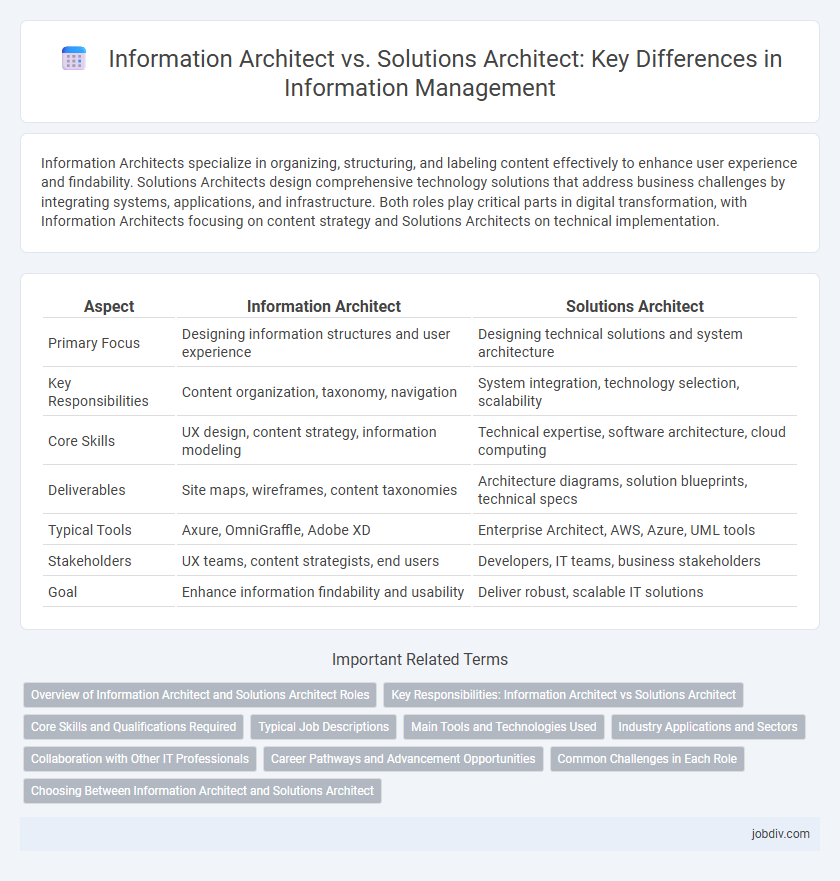Information Architects specialize in organizing, structuring, and labeling content effectively to enhance user experience and findability. Solutions Architects design comprehensive technology solutions that address business challenges by integrating systems, applications, and infrastructure. Both roles play critical parts in digital transformation, with Information Architects focusing on content strategy and Solutions Architects on technical implementation.
Table of Comparison
| Aspect | Information Architect | Solutions Architect |
|---|---|---|
| Primary Focus | Designing information structures and user experience | Designing technical solutions and system architecture |
| Key Responsibilities | Content organization, taxonomy, navigation | System integration, technology selection, scalability |
| Core Skills | UX design, content strategy, information modeling | Technical expertise, software architecture, cloud computing |
| Deliverables | Site maps, wireframes, content taxonomies | Architecture diagrams, solution blueprints, technical specs |
| Typical Tools | Axure, OmniGraffle, Adobe XD | Enterprise Architect, AWS, Azure, UML tools |
| Stakeholders | UX teams, content strategists, end users | Developers, IT teams, business stakeholders |
| Goal | Enhance information findability and usability | Deliver robust, scalable IT solutions |
Overview of Information Architect and Solutions Architect Roles
Information Architects focus on organizing and structuring digital content and data to enhance user experience and information accessibility. Solutions Architects design and oversee the implementation of technology solutions that meet business requirements, integrating software, hardware, and infrastructure components. Both roles require strong analytical skills but differ as Information Architects emphasize content strategy and usability, while Solutions Architects concentrate on technical system design and scalability.
Key Responsibilities: Information Architect vs Solutions Architect
Information Architects focus on organizing, structuring, and labeling content to improve usability, ensuring seamless navigation and user experience in digital environments. Solutions Architects design and implement complex IT systems, aligning technical solutions with business goals while ensuring scalability, security, and integration across platforms. Both roles require strong collaboration with stakeholders but emphasize different aspects of technology deployment and user engagement.
Core Skills and Qualifications Required
Information Architects require strong skills in user experience design, data modeling, and content strategy, along with qualifications in information science, human-computer interaction, or related fields. Solutions Architects must possess expertise in systems architecture, software development, and cloud technologies, supported by certifications such as AWS Certified Solutions Architect or Microsoft Certified: Azure Solutions Architect Expert. Core qualifications emphasize analytical problem-solving for Information Architects and technical competence in infrastructure and integration for Solutions Architects.
Typical Job Descriptions
Information Architects typically design the structure and organization of digital content to improve user experience and navigation by creating wireframes, sitemaps, and taxonomies. Solutions Architects focus on designing and implementing technical solutions, integrating systems, and ensuring scalability and security within IT infrastructure. Both roles require collaboration with stakeholders, but Information Architects emphasize user-centered design while Solutions Architects prioritize technical feasibility and system performance.
Main Tools and Technologies Used
Information Architects primarily utilize wireframing tools like Axure and Sketch, content management systems such as Drupal, and prototyping software including Adobe XD to structure and organize digital content effectively. Solutions Architects rely on cloud platforms like AWS and Azure, infrastructure-as-code tools such as Terraform, and containerization technologies including Docker and Kubernetes to design scalable, robust technology solutions. Both roles leverage collaboration tools like Jira and Confluence to streamline project workflows and communication.
Industry Applications and Sectors
Information Architects specialize in organizing and structuring data primarily for web and digital content management across industries such as e-commerce, publishing, and education. Solutions Architects design and implement technical infrastructure and software solutions tailored to sectors like finance, healthcare, and telecommunications, addressing complex business challenges. Both roles are critical in enterprise-level projects, with Information Architects enhancing user experience and data accessibility, while Solutions Architects ensure scalable, secure, and integrated IT systems.
Collaboration with Other IT Professionals
Information Architects collaborate closely with UX designers and content strategists to structure data and improve user experience, ensuring seamless navigation and accessibility across digital platforms. Solutions Architects work alongside software developers, system engineers, and project managers to design scalable, efficient IT infrastructures that meet organizational goals and technical requirements. Both roles require strong communication skills and teamwork to integrate diverse technical perspectives into coherent, effective solutions.
Career Pathways and Advancement Opportunities
Information Architects specialize in structuring digital content and user experiences, advancing through roles like UX Strategist or Content Strategist with a focus on user-centric design and data taxonomy expertise. Solutions Architects design and implement technology solutions, progressing towards Technical Director or Enterprise Architect positions by developing deep skills in systems integration and cloud platforms. Both career paths offer upward mobility in technology and management, with Solutions Architects often commanding higher salaries due to their technical depth and cross-functional impact on IT infrastructure.
Common Challenges in Each Role
Information Architects often face challenges such as organizing complex datasets for intuitive user navigation and ensuring information accessibility across diverse platforms. Solutions Architects struggle with integrating multiple technology systems while maintaining scalability, security, and compliance with industry standards. Both roles require effective stakeholder communication and balancing technical constraints with business goals to deliver optimal outcomes.
Choosing Between Information Architect and Solutions Architect
Choosing between an Information Architect and a Solutions Architect depends on your project's primary needs: Information Architects excel in structuring and organizing data, metadata, and user experience for effective information retrieval and usability. Solutions Architects specialize in designing and implementing technical solutions that align with business goals, integrating systems, and ensuring scalability and performance. Evaluate whether your focus is on optimizing information flow and user interaction or on developing comprehensive technical architectures to guide system development.
Information Architect vs Solutions Architect Infographic

 jobdiv.com
jobdiv.com